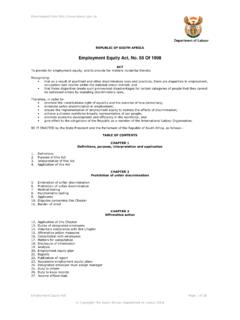Transcription of Chapter Seven: Code 500 – Measurement of the Preferential ...
1 Interpretive Guide to the Codes of Good Practice 2007 The Department of Trade and Industry 70 Chapter Seven: Code 500 Measurement of the Preferential Procurement Element of Broad-Based Black Economic Empowerment Statement 500 The General Principles for Measuring Preferential Procurement Introduction The Preferential Procurement element of the Generic Scorecard aims to address certain key issues surrounding supplier opportunities for BEE compliant enterprises, Qualifying Small Enterprises and Exempted Micro Enterprises as well as black-owned enterprises. These issues include: Preferential Procurement is used to drive transformation throughout the economy by encouraging procurement only from suppliers that are compliant with the B-BBEE scorecard: o There is a market tendency to interpret B-BBEE compliance as only having ownership by black people without looking at the level of compliance with other B-BBEE requirements.
2 This has resulted in a number of sham transactions/ fronting activities being entered into in a scramble to meet this compliance requirement. o Enterprises are encouraged to procure from those entities that have a good B-BBEE contribution level based on their performance on the scorecard. A supplier that has a very good B-BBEE contribution level is likely to be chosen as a preferred supplier as compared to his peers as they will give the enterprise they are providing goods and services to a good scoring on their own scorecard as well. Incentive to procure from Qualifying Small Enterprises and Exempted Micro enterprises. Statement 500 has a specific indicator for the recognition of BEE procurement spend from , Qualifying Small Enterprises (QSE s) and Exempted Micro Enterprises (EME s) by allocating specific scorecard points to procurement from these entities exclusively.
3 The Preferential Procurement Scorecard Compliance targets Criteria Weighting points Years 0-5 Years 6-10 B-BBEE Procurement Spend from all suppliers based on the B-BBEE Procurement Recognition Level as a percentage of Total Measured Procurement Spend 12 50% 70% Interpretive Guide to the Codes of Good Practice 2007 The Department of Trade and Industry 71B-BBEE Procurement Spend from Qualifying Small Enterprises or Exempted Micro-Enterprises based on the applicable B-BBEE Procurement Recognition Level as a percentage of Total Procurement Spend 3 10% 15% B-BBEE Procurement Spend from any of the following Suppliers as a percentage of Total Measured Procurement Spend Suppliers that are 50% black owned; and 3 9% 12% Suppliers that are 30% black women owned 2 6% 8% The Preferential Procurement scorecard offers B-BBEE procurement recognition from three categories of B-BBEE compliant suppliers.
4 These are summarized in the table below: BEE COMPLIANT SUPPLIERS WHICH WILL ENJOY Preferential PROCUREMENT RECOGNITION BENEFICIARY CATEGORY DESCRIPTION OF BENEFICIARY (A) BEE COMPLIANT SUPPLIERS Based on BEE contribution level Includes all BEE compliant companies: Of any size; With 30% or more on the Generic or QSE scorecards; and/or EMEs (B) QSE & EME SUPPLIERS Based on BEE contribution level Includes: QSE s proportional representation based on their score on the QSE scorecard to be applied; EME s proportional representation based on their deemed Level 4 status and Level 3 status if they are 50% black owned or 50% black women owned; (C) 50% BLACK-OWNED COMPANIES & 30% BLACK WOMEN OWNED COMPANIES Based purely on ownership status Includes BEE compliant companies: Large entities; QSEs; and EMEs that are 50% black owned or 30% black women owned BEE Procurement Recognition Levels For ease of reference, the BEE Procurement recognition levels as contained in Code 000 have been reproduced below.
5 Note that Exempted Micro Enterprises obtain an automatic, deemed Level 4 Contributor Status (100% BEE procurement recognition). BEE Status Qualification BEE procurement recognition level Level One Contributor 100 points on the Generic/ QSE Scorecard 135% Level Two Contributor 85 but <100 points on the Generic/ QSE Scorecard 125% Level Three Contributor 75 but <85 on the Generic/ QSE Scorecard 110% Level Four Contributor 65 but <75 on the Generic/ QSE Scorecard 100% Level Five Contributor 55 but <65 on the Generic/ QSE Scorecard 80% Interpretive Guide to the Codes of Good Practice 2007 The Department of Trade and Industry 72 Level Six Contributor 45 but <55 on the Generic/ QSE Scorecard 60% Level Seven Contributor 40 but <45 on the Generic/ QSE Scorecard 50% Level Eight Contributor 30 but <40 on the Generic/ QSE Scorecard 10% Non Compliant Contributor <30 on the Generic/ QSE Scorecard
6 0% Companies are recognised for additional points based on the status table above Customers (public and private sector) will prefer to interact and procure from companies with higher BEE status (for their own recognition) Exempted Micro Enterprises qualify for a promotion to the next BEE Recognition level if the enterprise is: - more than 50% owned by black people - more than 50% owned by black women Key Measurement principles 2. Enhanced Recognition for Procurement from the Measured Entity s Enterprise Development Beneficiaries A Measured Entity will enjoy enhanced recognition for procurement spend from any company which is also simultaneously one of its enterprise development beneficiaries. This will be at a multiple of see example below: 3.
7 Enhanced Recognition for Procurement from Value-Adding Suppliers ENHANCED RECOGNITION FOR SPEND ON ENTERPRISE DEVELOPMENT BENEFICIARIES For example: If Rand spend on Company A which is also an enterprise development beneficiary equals R100,000: = R100,000 X = R120,000 To calculate Preferential Procurement Spend (Company A is an EME in this example but the beneficiary need not necessarily be an EME) = Rand spend (taking into account enhanced recognition) X BEE procurement recognition level = R120,000 X 100% (EME = deemed Level 4 Contributor = 100% BEE recognition level) = R120,000 A Measured Entity will enjoy enhanced recognition for procurement spend from any company which is also a Value Adding Supplier. This will be at a multiple of REWARDING VALUE-ADDING SUPPLIERS WHICH PRODUCE LOCALLY Value-Adding Suppliers beneficiate or add value to raw materials and tend to manufacture and produce locally, rather than relying too heavily on imports in most cases.
8 The objective of this enhanced recognition is to encourage local production. NB: Value-adding suppliers still need to meet the Preferential Procurement scorecard requirements for any procurement spend on such suppliers to be recognised for B-BBEE scoring purposes. Example ENHANCED RECOGNITION FOR SPEND ON VALUE ADDING SUPPLIERS For example: If Rand spend on Company A which is also a value adding supplier equals R100,000: = R100,000 X = R125,000 Company A is a level 5 contributor To calculate Preferential Procurement Spend = Rand spend (taking into account enhanced recognition) X BEE procurement recognition level = R125,000 X 80% (Level 5 Contributor = 80% BEE recognition level) = R100,000 Note Had Company A not been a value adding supplier the company procuring goods and services from Company A would claim Preferential procurement points based on the following calculated amount.
9 = Rand spend X BEE procurement recognition level =R100,000 X 80% =R80,000 Interpretive Guide to the Codes of Good Practice 2007 The Department of Trade and Industry 73 Interpretive Guide to the Codes of Good Practice 2007 The Department of Trade and Industry 744. Enhanced Recognition for Black Owned Professional Service Providers and Entrepreneurs A Measured Entity will enjoy enhanced recognition for procurement from Professional Services Providers and Entrepreneurs who are black owned. It must be noted that it is the intention of this Code to encourage procurement from such service providers who have a shareholding in excess of 50% and that such services are in the professional and consulting arenas of service provision.
10 It is also the intention of the code to encourage the use of local service providers and it is therefore assumed that such black owned service providers and entrepreneurs will incur a majority of the costs related to this service provision locally. A non-exhaustive list of examples of such service providers is detailed below. Professional and Consulting Services shall mean:- Accounting and Auditing Actuarial Sciences Advertising Marketing Any other professional and consulting services Architectural services Asset/Fund Management Services Corporate Finance related services Engineering services (all kinds of engineering disciplines) Financial Advisory Services HR Consulting Services Information Technology Services and Consulting Legal Services (including all legal related services)

